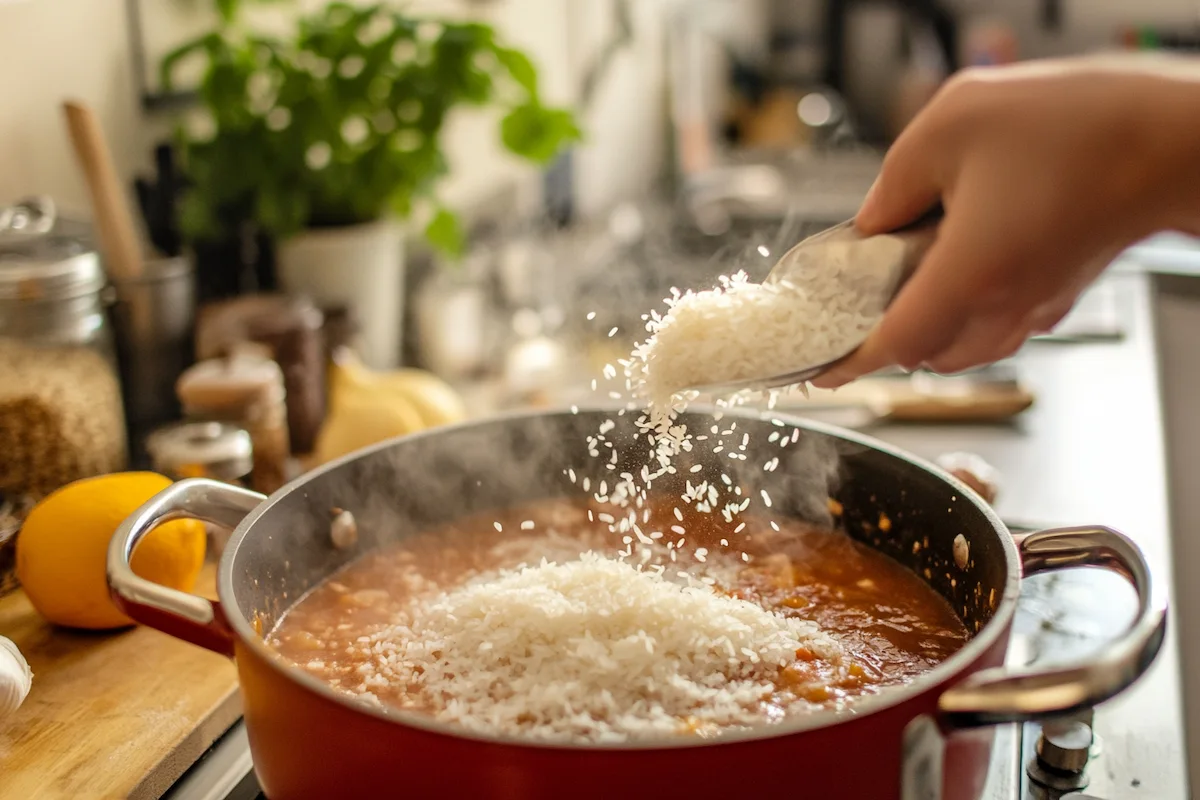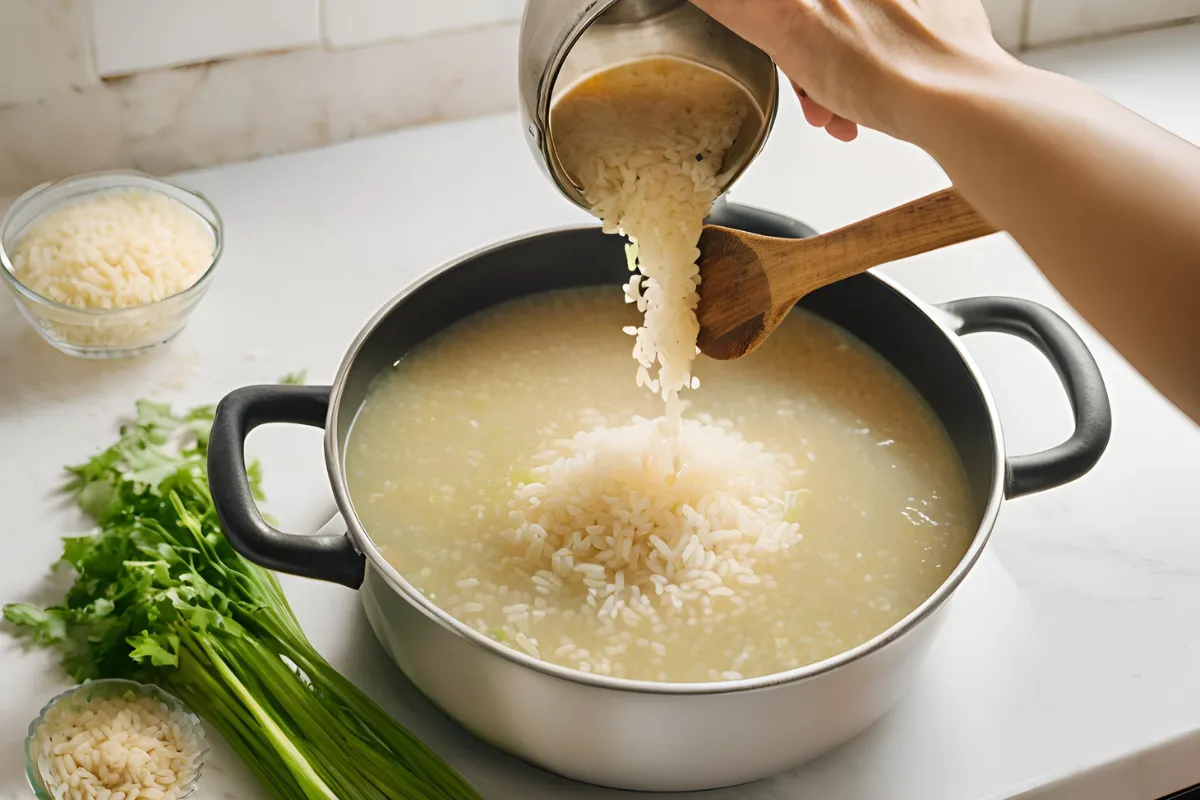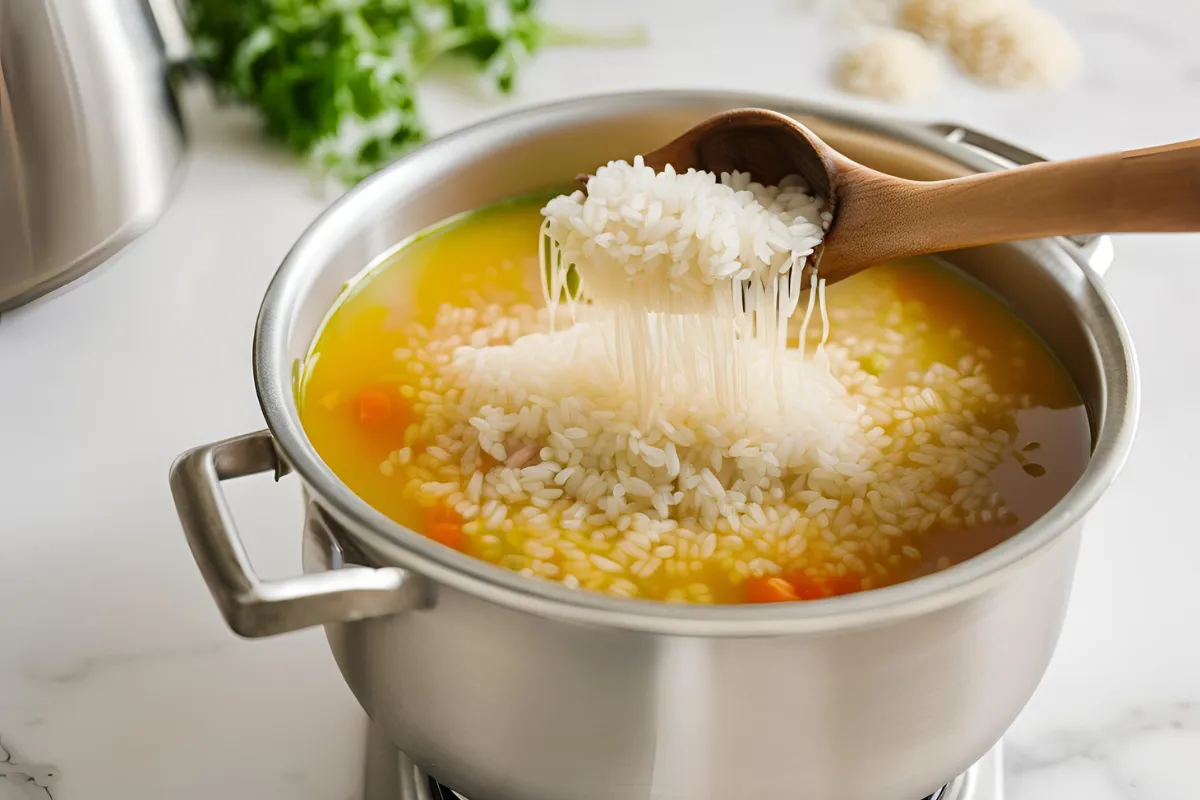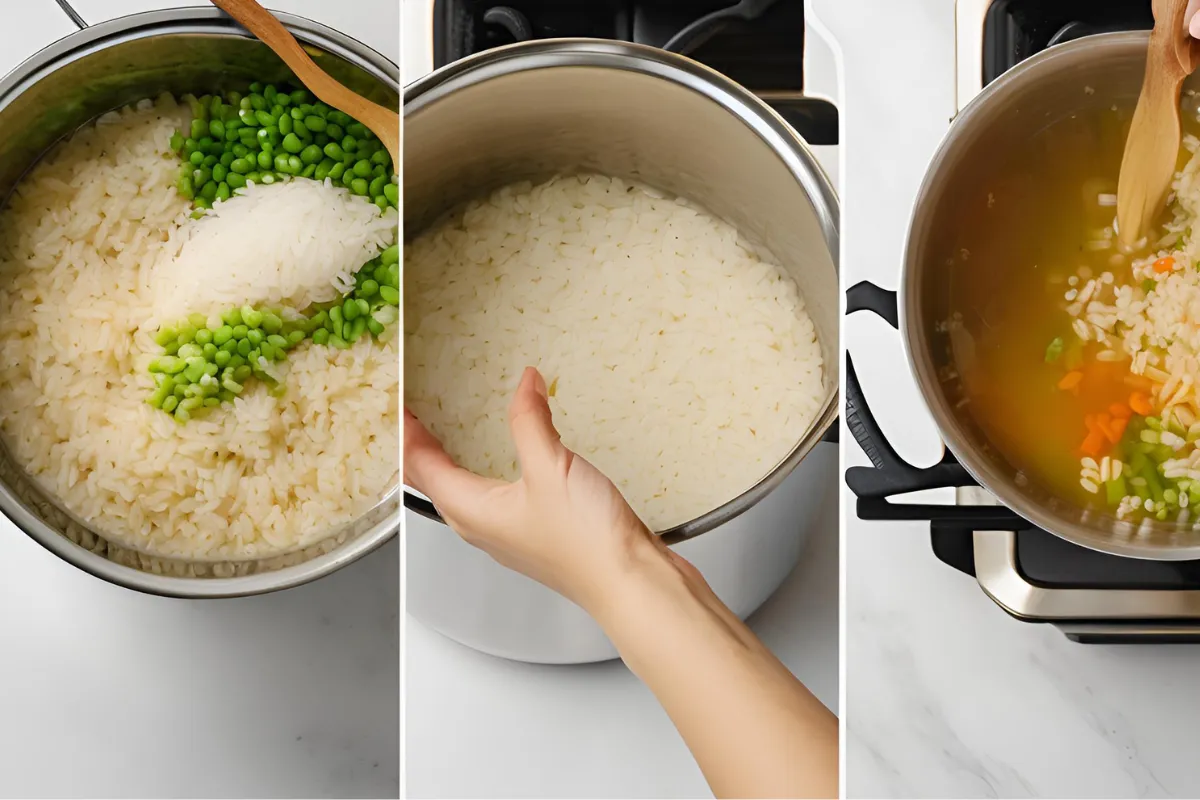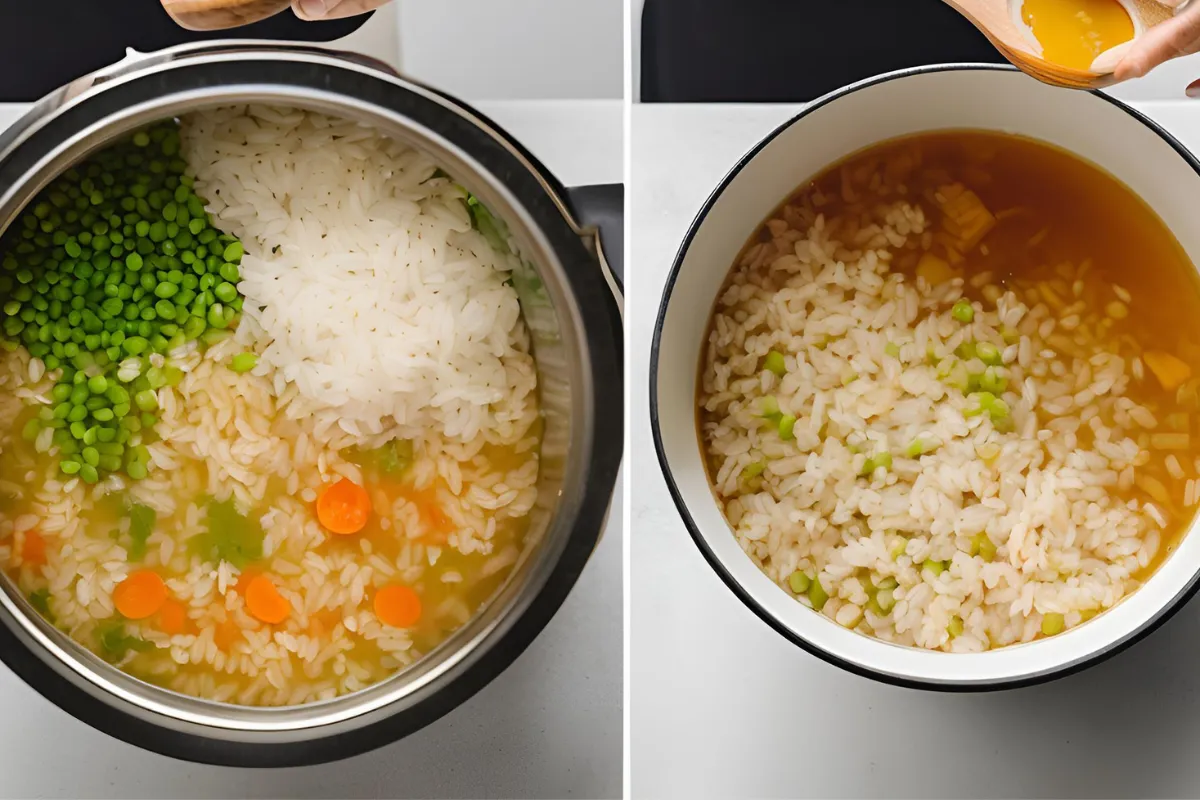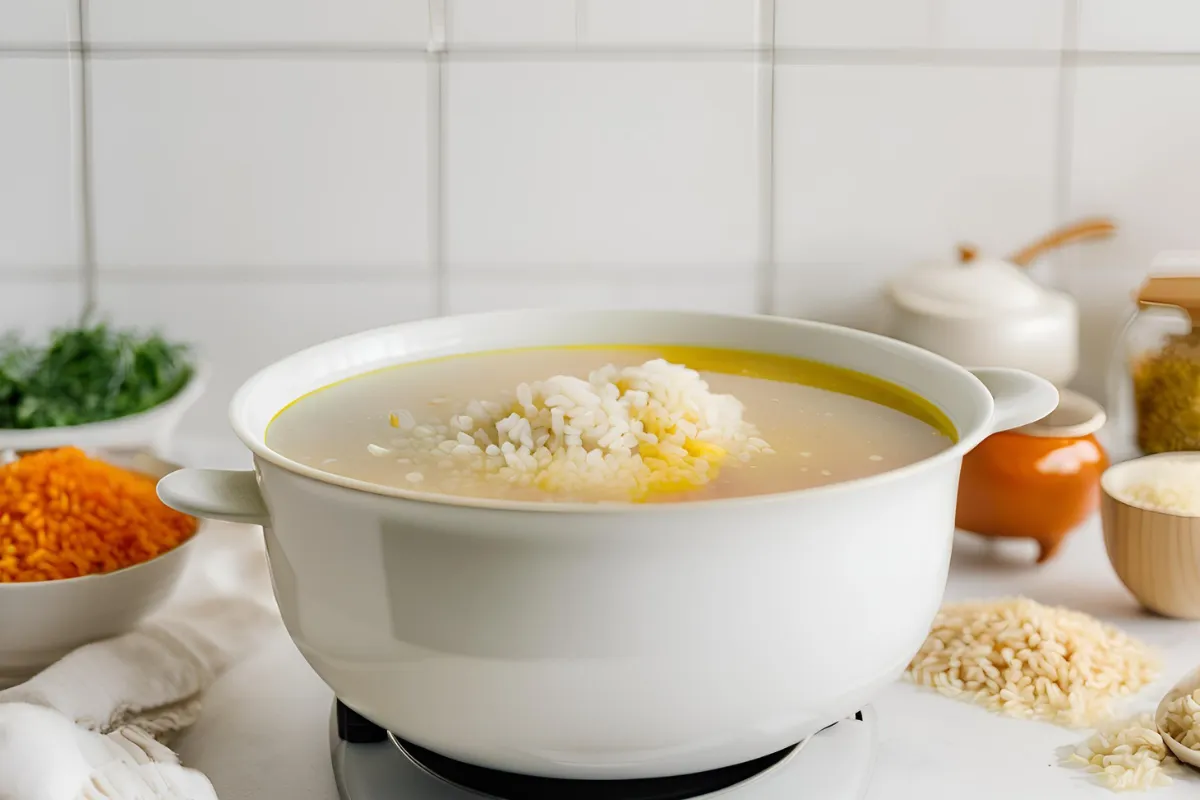Introduction
When it comes to making the perfect bowl of soup, the addition of rice can make all the difference. But here’s a question that often pops up in the kitchen: Do I cook rice before adding to soup? It’s a valid query that many home cooks and even professional chefs grapple with. After all, rice can be a great ingredient to include in soups, adding texture, heartiness, and nutrition. Yet, there’s some confusion around whether you should pre-cook the rice or toss it in uncooked. Should you cook the rice separately, or can you throw it directly into the soup pot without any prior cooking?
In this article, we’ll dive deep into this question, providing insights, tips, and methods to help you decide what’s best for your soup. By the end, you’ll know whether to pre-cook your rice, add it uncooked, or use a combination of both methods. Plus, we’ll explore which types of rice are best for soups and how to maintain that perfect consistency every time. Let’s get started!
Why Add Rice to Soup?
Rice is an incredibly versatile ingredient, often serving as a foundation for hearty meals. When added to soup, it brings more than just substance—it enhances the overall texture and flavor profile. But why do so many people turn to rice in their soups?
Adding rice to soup has several advantages. First and foremost, it adds a natural, comforting thickness to the soup. Rice absorbs the flavors of the broth, making each spoonful a deliciously rich experience. Depending on the type of rice used, it can also add subtle earthy or floral notes to the dish. Plus, rice helps to stretch out the soup, making it a more filling and satisfying meal.
But with all that said, the big question remains: do I cook rice before adding it to soup?
What Happens if Rice is Added Uncooked to Soup?
If you’re wondering whether it’s okay to add uncooked rice directly to your soup, the answer isn’t as straightforward as a simple “yes” or “no.” While it’s possible to add uncooked rice, there are a few things you should keep in mind.
When you throw uncooked rice into your soup, it will absorb much of the liquid. This can actually be a great method for thickening your soup, especially if you’re looking for a hearty, rustic feel. However, this also means your soup could become thicker and more starchy over time. It can also significantly increase the cooking time. You’ll need to make sure you’re allowing enough time for the rice to cook fully, or else you might end up with hard rice in the middle of your soup.
Additionally, adding uncooked rice can affect the final texture of your soup. If not monitored carefully, the rice may absorb too much liquid, leaving the soup drier than intended. It’s essential to adjust your liquid-to-rice ratio accordingly, so your soup doesn’t end up too thick or too thin. But what about the flavor? Well, uncooked rice will absorb all the flavors of your broth, so it’s definitely an option for those who like their rice more infused with the taste of the soup.
However, there’s a downside. If you add too much rice or let it cook for too long, you risk losing that delicate balance between broth and rice. You could end up with a mushy texture that’s less than appetizing. So, while it’s possible to add uncooked rice directly into your soup, it’s important to monitor it carefully.
Benefits of Cooking Rice Before Adding to Soup
The Advantages of Cooking Rice Separately Before Adding to Soup
If you’re considering cooking rice separately before adding it to your soup, there are several distinct benefits to this method. One of the primary advantages is that it allows you to have more control over the texture of the rice. Cooking it beforehand ensures it’s perfectly tender, but not mushy. By pre-cooking the rice, you guarantee it stays fluffy and separate when added to the soup, rather than absorbing too much broth or becoming overly soft.
Another benefit of cooking rice separately is that it helps maintain the final consistency of your soup. If you’re aiming for a lighter, broth-based soup, cooking the rice first lets you add it without it soaking up too much of the liquid. This way, the soup retains a more balanced ratio of broth to rice, creating a more refined texture overall.
Why Pre-Cooking Rice Works for Timing and Consistency
An additional benefit of cooking rice separately is the control it gives you over the timing. Rice has a different cooking time compared to most soups. By cooking it beforehand, you don’t have to worry about adjusting the cooking time of the rice to align with the soup’s readiness. This allows you to avoid the frustration of waiting for rice to finish cooking while your soup is already perfectly done.
Adding pre-cooked rice towards the end of the cooking process makes it easy to heat it through without the risk of overcooking. However, this method isn’t always the best for every soup. The type of soup and the desired flavor profile will influence whether pre-cooking is the ideal choice. In the next section, we’ll explore the various methods for adding rice to your soup—both pre-cooked and uncooked—and discuss the benefits of each approach.
How to Add Rice to Soup (With or Without Cooking it First)
When you’re cooking a delicious soup, deciding whether to cook rice beforehand or add it uncooked is an important consideration. Both methods have their advantages, but knowing when and how to use each can make all the difference in achieving the perfect texture and flavor balance. In this section, we’ll explore both options and guide you through the best practices for adding rice to your soup.
Different Ways to Cook Rice for Soup
There are two main ways to incorporate rice into your soup: pre-cooking it or adding it uncooked. Each method has its own set of pros and cons, so let’s take a closer look at both.
Cooking Rice Before Adding to Soup
This is the most traditional method. You cook your rice separately, then add it to the soup once it’s fully cooked. This method allows you to control the texture of the rice more easily, ensuring it remains fluffy and doesn’t absorb too much liquid. If you’re aiming for a soup with a clear broth or lighter consistency, this method is ideal. You can also season the rice separately, ensuring that the flavors don’t overwhelm the soup itself.
Adding Rice Directly to the Soup Without Pre-Cooking
In this method, you add the uncooked rice directly into the simmering soup. As the soup cooks, the rice absorbs the liquid and flavor of the broth. This is an excellent technique for soups that are meant to be thick, like chowders or stews. The rice will help thicken the soup and take on the flavors of the broth, giving the soup a more cohesive texture. However, this method requires more attention to the timing, as rice can easily become mushy if overcooked.
The Case for Cooking Rice Before Adding to Soup
There are several reasons why cooking rice separately before adding it to soup might be the better option.
Why Cooking Rice Separately Might Be Better for Texture
When you cook rice on its own, you have more control over the texture. The rice will stay separate and fluffy rather than becoming one with the soup. This is especially important if you want a clear broth or a lighter, more refined soup. Pre-cooking the rice allows it to hold its shape and texture, ensuring it doesn’t turn mushy or overly soggy.
How It Can Impact the Overall Flavor of the Soup
Cooking the rice separately also lets you season it more precisely. You can add flavorings like butter, herbs, or a pinch of salt directly to the rice, which can enhance its taste without overpowering the flavor of the soup. This method allows the rice to add a subtle layer of flavor to the soup without becoming the dominant taste.
The Right Time to Add Cooked Rice to the Soup
Once your rice is cooked, add it to the soup toward the end of the cooking process. You don’t need to cook it further—just heat it through. This prevents overcooking the rice, preserving its ideal texture. If you add cooked rice too early, it may absorb too much liquid, causing the soup to become too thick.
The Case for Adding Rice Uncooked to Soup
There are times when adding rice directly to the soup uncooked is not only acceptable but also preferable. This method works particularly well for certain types of soups.
How Uncooked Rice Absorbs Flavors in the Soup
One of the key advantages of adding uncooked rice to your soup is that it absorbs the broth’s flavors as it cooks. The rice soaks up all the rich spices, herbs, and seasonings in the soup, making it more flavorful. This method is great for heartier soups, like chicken and rice soup, where the rice becomes an integral part of the dish, melding with the soup rather than remaining separate.
Ideal Soups Where Adding Uncooked Rice is Appropriate
Certain soups lend themselves better to uncooked rice. Stews, chowders, and creamy soups are often great candidates for this method. For instance, adding uncooked rice to a hearty vegetable soup can help thicken the broth while adding body. The rice will absorb some of the liquid, giving the soup a thicker, more substantial texture.
The Cooking Method and Timing for Uncooked Rice
When you add uncooked rice to soup, make sure the soup is simmering rather than boiling rapidly. Boiling can make the rice cook unevenly. Once you add the rice, keep the soup at a gentle simmer, allowing the rice to cook fully. Depending on the type of rice, it can take anywhere from 15 to 30 minutes to cook. Just be sure to check the rice as it cooks to avoid overcooking it.
The Impact on Cooking Time and Soup Texture
Whether you choose to cook rice separately or add it uncooked, both methods will impact the cooking time and texture of your soup.
How Uncooked Rice Affects Soup Consistency
Uncooked rice will thicken your soup as it cooks. This can be great for creating a creamy, hearty texture, especially in soups with a broth-based foundation. However, be aware that adding too much uncooked rice or cooking it for too long can result in a mushy soup that is more like a porridge than a soup.
What to Expect in Terms of Texture if Rice is Added Before Cooking
If you add uncooked rice to your soup too early, the rice will continue to absorb liquid, eventually thickening the soup and changing its consistency. This is ideal for soups that need a thicker texture, but it requires a bit of attention. The longer the rice sits in the soup, the thicker the soup will become. If you prefer a more soupy consistency, be sure to adjust the liquid levels accordingly.
Time Adjustments Required for Each Method
If you cook rice separately, you don’t need to worry about the rice affecting the overall soup cooking time. You can simply heat the cooked rice through at the end. However, when adding uncooked rice, you’ll need to account for extra cooking time, which can vary depending on the type of rice. White rice typically cooks in 15–20 minutes, while brown rice may take closer to 30 minutes. Make sure to adjust the cooking time and check the soup regularly for the desired consistency.
In summary, whether you cook your rice beforehand or add it uncooked to your soup depends on your preferred soup texture and flavor. Pre-cooking the rice gives you more control over the final dish, while adding uncooked rice can enrich the soup with additional flavor. Understanding the impact of each method on cooking time and texture will help you create the perfect soup for any occasion.
Choosing the Right Rice for Soup
Selecting the right rice for your soup can make a significant difference in the final dish. Different types of rice bring unique textures, flavors, and consistencies to your soup. Let’s explore which types of rice work best for soups, how they affect the texture, and some tips for pre-cooking rice before adding it to your soup.
Types of Rice for Soup: Which Works Best?
There are several types of rice that you can use in soups, each offering its own characteristics. Let’s take a look at some of the most popular options:
White Rice
White rice is the most common rice used in soups. It cooks quickly and absorbs flavors well, making it a go-to choice for light, broth-based soups. It can become a little sticky and soft if cooked too long, but it’s generally easy to use in most recipes.
Brown Rice
Brown rice is a heartier option with more fiber and nutrients than white rice. It takes longer to cook and can absorb more liquid, which is great for thicker soups. It maintains a firmer texture than white rice, even after long cooking times, so it’s a good choice for soups where you want the rice to hold its shape.
Wild Rice
Technically not a true rice, wild rice is an excellent choice for soups that need a nutty, earthy flavor. It has a chewier texture than other types of rice and can add variety to your dish. Wild rice takes longer to cook than white rice but holds up well in soups, making it ideal for rustic, hearty stews.
Jasmine Rice
Jasmine rice, known for its fragrant aroma, works well in Asian-inspired soups, such as Thai or Chinese recipes. It cooks quickly and has a soft, slightly sticky texture when cooked, which makes it great for brothy soups. Its distinct floral scent enhances the flavor profile of the soup, making it a good match for light, fragrant broths.
Arborio Rice
Arborio rice is a short-grain rice commonly used in risottos, but it can also work well in creamy soups, where its starchiness contributes to a thick, rich texture. It releases more starch than most rice types, so it’s perfect for those looking to make a more luxurious, velvety soup.
How Rice Affects Soup Consistency
The type of rice you choose will directly impact the consistency of your soup, largely due to the starch content in each variety. Rice starch is released during cooking and plays a crucial role in determining how thick or thin your soup will be.
Starch Levels in Different Rice Types
Rice varieties like white rice and arborio rice tend to release more starch as they cook, which thickens the soup. In contrast, brown rice and wild rice release less starch, allowing the soup to remain lighter and more brothy. If you want a creamy, thicker soup, choosing a rice variety with a higher starch content will help achieve that texture.
How Starch Impacts Soup Thickness and Texture
As rice cooks, the starch absorbs liquid, causing the soup to thicken. This is especially noticeable in soups like risotto or chowder, where the rice helps to create a creamier texture. For a thinner, broth-based soup, you may want to choose a rice that doesn’t release as much starch, or simply control the cooking time to prevent the rice from absorbing too much liquid.
Pre-Cooking Rice for Soup: Tips for Success
If you’ve decided to cook the rice separately before adding it to your soup, there are a few things to keep in mind to ensure success.
Best Methods for Cooking Rice Before Adding to Soup
The best way to pre-cook rice is by boiling it in a separate pot. This allows you to control the rice’s texture more effectively. Start by rinsing the rice to remove excess starch, which can make the soup too thick. Then, cook the rice according to the package instructions, using a rice-to-water ratio of about 1:2 for white rice and 1:2.5 for brown rice. Once cooked, you can add the rice directly to the soup or keep it separate until serving.
How to Prevent Overcooking Rice When Adding to Soup
The key to preventing overcooked rice is to add it to the soup only towards the end of the cooking process. If you add rice that has already been cooked, it just needs to be heated through, so give it only a few minutes in the hot soup. This way, the rice won’t become overly soft or mushy.
The Best Rice-to-Liquid Ratio for Soup
If you’re adding rice directly to the soup while it’s cooking, the rice-to-liquid ratio is crucial. For white rice, use about 1/4 to 1/3 cup of uncooked rice per serving of soup. For brown rice, the ratio may be slightly higher due to its longer cooking time. Be mindful of the liquid levels as the rice absorbs water; you may need to add more broth during the cooking process to keep the soup at your desired consistency.
Choosing the right rice for your soup is essential to achieving the perfect texture and flavor. Whether you’re using rice to thicken the broth or adding it as a complementary texture, the type of rice you select can greatly impact the outcome of your dish. Be sure to experiment with different rice types and pre-cooking methods to discover the best combination for your favorite soups.
Tips and Tricks
Getting the right texture and flavor when cooking rice in soup can be a challenge, but with a few expert tips, you can master the process and create a bowl of soup that’s both hearty and delicious. Here’s how you can ensure your rice stays perfect in your next soup.
How to Prevent Rice from Becoming Too Mushy in Soup
Rice can easily turn mushy in soup if you’re not careful. The key is to avoid overcooking it. When rice is added to a simmering soup, it continues to absorb liquid and expand. If you leave it in the soup too long, especially when the soup is bubbling at a high temperature, the rice will lose its firm texture and become soggy.
Overcooking Rice and How to Avoid It
The best way to avoid overcooking your rice is to pay attention to timing. If you’re adding uncooked rice to the soup, make sure the soup isn’t at a rolling boil when you add it. Instead, let it simmer gently so the rice can cook slowly. For pre-cooked rice, add it toward the end of the cooking process and only let it simmer for a few minutes to heat through. This prevents it from breaking down and becoming mushy.
How to Maintain a Perfect Rice Texture
To maintain that perfect rice texture, keep an eye on the liquid levels. If you notice the rice is absorbing too much broth, you can always add a bit more liquid to maintain the soup’s consistency. Also, if you’re cooking rice separately, make sure it’s cooked until it’s just tender but still firm. When added to soup, it will absorb some liquid, making it the perfect complement to the broth without turning soggy.
Adjusting Rice Amounts in Soup
When it comes to adding rice to your soup, less is more. It’s easy to add too much rice, especially if you’re trying to stretch a soup for more servings. But finding the right balance is key to achieving the ideal consistency.
How Much Rice Should You Add to Soup?
Generally, you should use about 1/4 to 1/3 cup of uncooked rice for every 1 cup of liquid in the soup. This can vary depending on the type of soup you’re making and how much thickening you want. For a brothy soup, you don’t want to overload it with rice, as it can quickly turn into a thick stew. For thicker soups or stews, you can add more rice to achieve the desired consistency. The rule of thumb is to start with less rice and add more as needed, keeping in mind that rice expands significantly as it cooks.
Balancing Rice with Other Ingredients for the Perfect Texture
Rice isn’t the only ingredient in your soup, so it’s important to balance it with the other components. If your soup has a lot of vegetables, meats, or legumes, you may need less rice. It’s also important to consider the cooking time for each ingredient. For example, some vegetables may cook faster than the rice, so be sure to add them at different stages. A good balance will ensure your soup has a nice texture where every ingredient complements the others, rather than overwhelming the dish with too much rice.
Seasoning Tips
Rice itself can be quite neutral, so seasoning it properly is essential for enhancing the overall flavor of the soup.
How to Season Rice to Enhance Its Flavor in the Soup
You can season rice before adding it to the soup or allow the rice to absorb the seasonings from the broth. If cooking the rice separately, try adding a little salt, a bay leaf, or even a knob of butter during cooking to give it some depth of flavor. You could also stir in herbs like thyme, rosemary, or parsley, which will infuse the rice with subtle aromatics. If you’re adding uncooked rice directly into the soup, season the broth well, as the rice will absorb much of the flavor.
The Best Spices and Seasonings to Pair with Rice in Soup
Some spices pair beautifully with rice in soups. For a more savory flavor, consider adding garlic, onion powder, or cumin. If you’re making a more aromatic soup, ginger, turmeric, or saffron can be fantastic additions. For a fresh, light flavor, try a bit of lemon zest or fresh basil. These seasonings will not only flavor the rice but will also enhance the overall profile of the soup.
Storage and Reheating
If you’ve made a big batch of soup and want to store it for later, you can definitely keep rice soup for another day. However, rice can change in texture when stored, so it’s important to know how to store and reheat it properly.
Can You Store Rice Soup for Later?
Yes, you can store rice soup! In fact, it often tastes even better the next day as the flavors have had time to meld. Just be aware that the rice will continue to absorb liquid as the soup sits, so it may become thicker. You can always add extra broth when reheating to bring it back to the desired consistency. Be sure to let the soup cool completely before storing it in an airtight container in the fridge for up to 3–4 days.
How to Store and Reheat Rice Soup Without Losing Flavor or Texture
When reheating, do so slowly over low heat to prevent the rice from becoming too mushy. You can add a bit of water or broth to loosen the soup and restore its original texture. If you’ve stored the soup with the rice already in it, the rice will likely be softer, but this can still be delicious, especially if you’ve made a creamy or hearty soup. For soups with rice that are stored separately, the rice will retain a firmer texture and will heat up nicely without losing much quality.
These tips and tricks will help you achieve the perfect texture, flavor, and consistency when cooking rice in soup. Whether you’re adding it before or after cooking, controlling the amount, seasoning it well, and properly storing and reheating your soup are key steps to making the best rice soup every time. Enjoy experimenting and finding the method that works best for you!
FAQs
How long does it take for rice to cook in soup?
The time it takes for rice to cook in soup depends on the type of rice and whether it’s added uncooked or pre-cooked. Uncooked white rice typically takes around 15–20 minutes to cook in simmering soup, while brown rice may take up to 30–40 minutes. For pre-cooked rice, you just need to heat it through, which usually takes about 5 minutes. Always check the rice for doneness before serving to ensure it’s perfectly tender.
What type of rice is best for soup?
The best type of rice for soup depends on the texture and flavor you’re aiming for. White rice, such as long-grain or basmati, works well in clear broths or lighter soups because it cooks quickly and remains fluffy. Brown rice adds a nutty flavor and works well in hearty soups or stews. Wild rice is perfect for soups with a richer, more complex broth. Jasmine rice adds a fragrant aroma, making it ideal for Asian-style soups. Choose based on the flavor profile and cooking time.
Can I add leftover rice to soup?
Yes! Leftover rice can be added directly to your soup. It’s a great way to repurpose cooked rice and save time. Just add it to the soup near the end of cooking, allowing it to heat through. You may need to adjust the liquid levels, as the rice may have absorbed some moisture while stored. If the soup thickens too much, simply add a bit more broth or water.
How do I avoid rice becoming mushy in soup?
To avoid mushy rice, don’t overcook it. If adding uncooked rice, let the soup simmer gently rather than boiling vigorously. If pre-cooking rice, make sure it’s tender but not overdone before adding it to the soup. Add the rice towards the end of cooking and monitor it to ensure it retains its texture.
How do you keep rice from getting mushy in soup?
The key is to control the cooking time and liquid absorption. Add uncooked rice only when the soup is simmering, not boiling. If cooking rice separately, avoid overcooking it before adding it to the soup. Also, be mindful of the rice-to-liquid ratio. Too much rice or liquid can make the soup too thick, leading to mushy rice.
How to add uncooked rice to soup?
To add uncooked rice to soup, simply stir it in once the soup is simmering. Let it cook slowly until tender, usually 15–30 minutes depending on the rice variety. Keep the heat low to ensure even cooking and prevent the rice from becoming mushy. If needed, adjust the soup’s liquid levels, as the rice will absorb some broth.
What rice doesn’t get mushy in soup?
Certain types of rice are less prone to becoming mushy in soup. Long-grain white rice, such as basmati or jasmine rice, tends to stay separate and fluffy. Wild rice also holds its shape well in soup and provides a pleasant chewy texture. Brown rice, while heartier, can sometimes become a bit softer, but still retains a satisfying texture if cooked properly.
Conclusion
In conclusion, the question “Do I cook rice before adding to soup?” doesn’t have a one-size-fits-all answer. It ultimately depends on the texture, flavor, and consistency you’re aiming for in your soup. Whether you choose to cook the rice separately or add it uncooked, each method brings something unique to the dish. Cooking rice separately gives you more control over its texture, ensuring it remains fluffy and distinct in the soup, while adding uncooked rice allows it to absorb the flavors of the broth and thicken the soup.
Best practices for adding rice to soup depend on your preferred result. If you’re looking for a lighter, clearer broth, pre-cooking the rice and adding it at the end is the way to go. On the other hand, if you’re after a heartier, thicker soup, adding uncooked rice to the soup will help it absorb the flavors and expand as it cooks. Adjusting the rice-to-liquid ratio and being mindful of cooking times will ensure the perfect texture every time.
Don’t be afraid to experiment with different types of rice and cooking methods. Basmati rice works wonderfully for lighter soups, while brown rice can add a rich, nutty flavor to heartier stews. Wild rice can give your soup a unique texture and depth. Regardless of your choice, each type of rice offers something special, so get creative and find the combination that works best for you.
Ultimately, whether cooked separately or added directly, rice can elevate your soup to a whole new level. So, grab a spoon and start experimenting—you’ll soon discover your own favorite method for cooking rice in soup!

